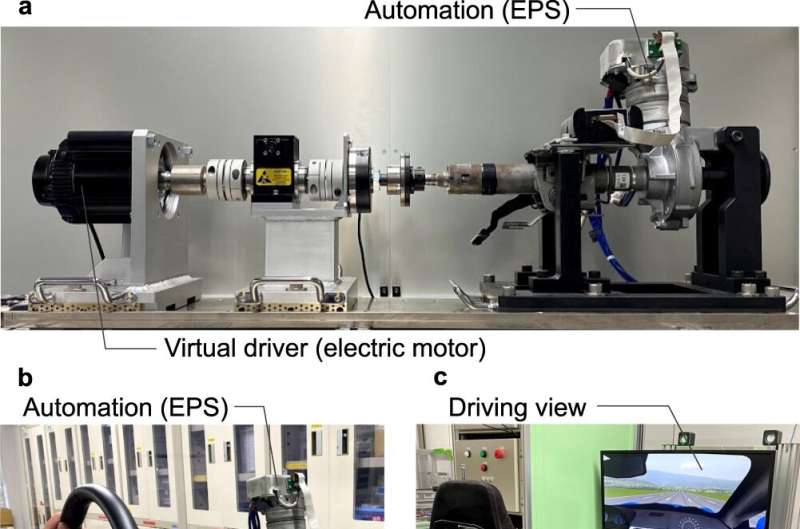This article has been reviewed according to Science X's editorial process and policies. Editors have highlighted the following attributes while ensuring the content's credibility:
fact-checked
trusted source
proofread
Autonomous steering system keeps human drivers engaged

Researchers from EPFL and JTEKT Corporation have developed an automated driving system based on the concept of "collaborative steering," which aims to increase transportation safety, efficiency, and comfort by encouraging active interaction between autonomous vehicles and their human drivers.
Autonomous driving technologies have already been integrated into many mass-produced vehicles, providing human drivers with steering assistance in tasks like centering a vehicle in its lane. But the little data available on automated driving safety shows that placing too much control of a vehicle in the hands of automation can do more harm than good, as disengagement by human drivers can increase the risk of accidents.
"Current vehicles on the market are either manual or automated, and there is no clear way of making their control a truly shared experience. This is dangerous, because it tends to lead to driver over-reliance on automation," explains Jürg Schiffmann, head of the Laboratory for Applied Mechanical Design in the School of Engineering.
Now, researchers from the lab have collaborated with Japanese steering system supplier JTEKT Corporation to develop and successfully road-test a haptics-based automated driving system that integrates different modes of human-robot interaction. The researchers hope that their approach will increase not only the safety of automated driving, but also social acceptance of it.
"This research was based on the idea that automation systems should adapt to human drivers, and not vice versa," says EPFL Ph.D. student and JTEKT researcher Tomohiro Nakade, who is also the first author on a recent paper describing the system published in the journal Communications Engineering.
Nakade adds that a good metaphor for the new system can be drawn from a transportation mode that predates automation: "A vehicle must be open to negotiation with a human driver, just as a horseback rider conveys his or her intention to the horse through the reins."
Interaction, arbitration, and inclusion
Unlike current automated driving systems, which use only cameras for sensory input, the researchers' more holistic approach integrates information from a car's steering column. It also encourages continuous engagement between driver and automation, as opposed to current automated systems, which are typically either switched on or off.
"In automation in general, when humans are just monitoring a system but not actively involved, they lose the ability to react," says Robert Fuchs, a former EPFL Ph.D. student who is now an R&D general manager at JTEKT Corporation. "That's why we wanted to actively improve driver engagement through automation."
The researchers' system achieves this thanks to three functionalities: interaction, arbitration, and inclusion. First, the system distinguishes between four different types of human-robot interaction: cooperation (the automation supports the human in achieving a goal); coactivity (the human and automation have different goals, but their actions impact one another); collaboration (human and automation assist one another in achieving different goals); and competition (human and automation activities are in opposition).
Next, as the driver operates the vehicle, the system arbitrates, or moves between different interaction modes depending on the evolving situation on the road. For example, the car might switch from collaboration to competition mode to avoid a sudden collision threat.
Finally, and still within the same control framework, the system integrates an 'inclusion' function: it recomputes the vehicle's trajectory whenever the driver intervenes—by turning the steering wheel, for example—rather than perceiving it as an override and switching off.
A practical solution
To test their system, the researchers developed experiments involving a simulated virtual driver and a human driver using a detached power steering system, a full driving simulator, and even field tests with a modified test vehicle. The field tests were carried out with the participation of five drivers on a JTEKT test course in Japan's Mie prefecture, by connecting the researchers' system to a standard sedan via an external controller.
The researchers specifically tested drivers' experiences of steering smoothness and lane-changing ease, and their results confirmed the system's significant potential for increasing comfort and reducing effort for drivers through collaborative steering.
"This is a very practical concept—it's not just research for research's sake," says Schiffmann, adding that the software-based system can be integrated into standard mass-produced cars without any special equipment. "It's also a beautiful example of a fruitful partnership between our lab and JTEKT, with whom EPFL has collaborated since 1998."
More information: Tomohiro Nakade et al, Haptics based multi-level collaborative steering control for automated driving, Communications Engineering (2023). DOI: 10.1038/s44172-022-00051-2



















